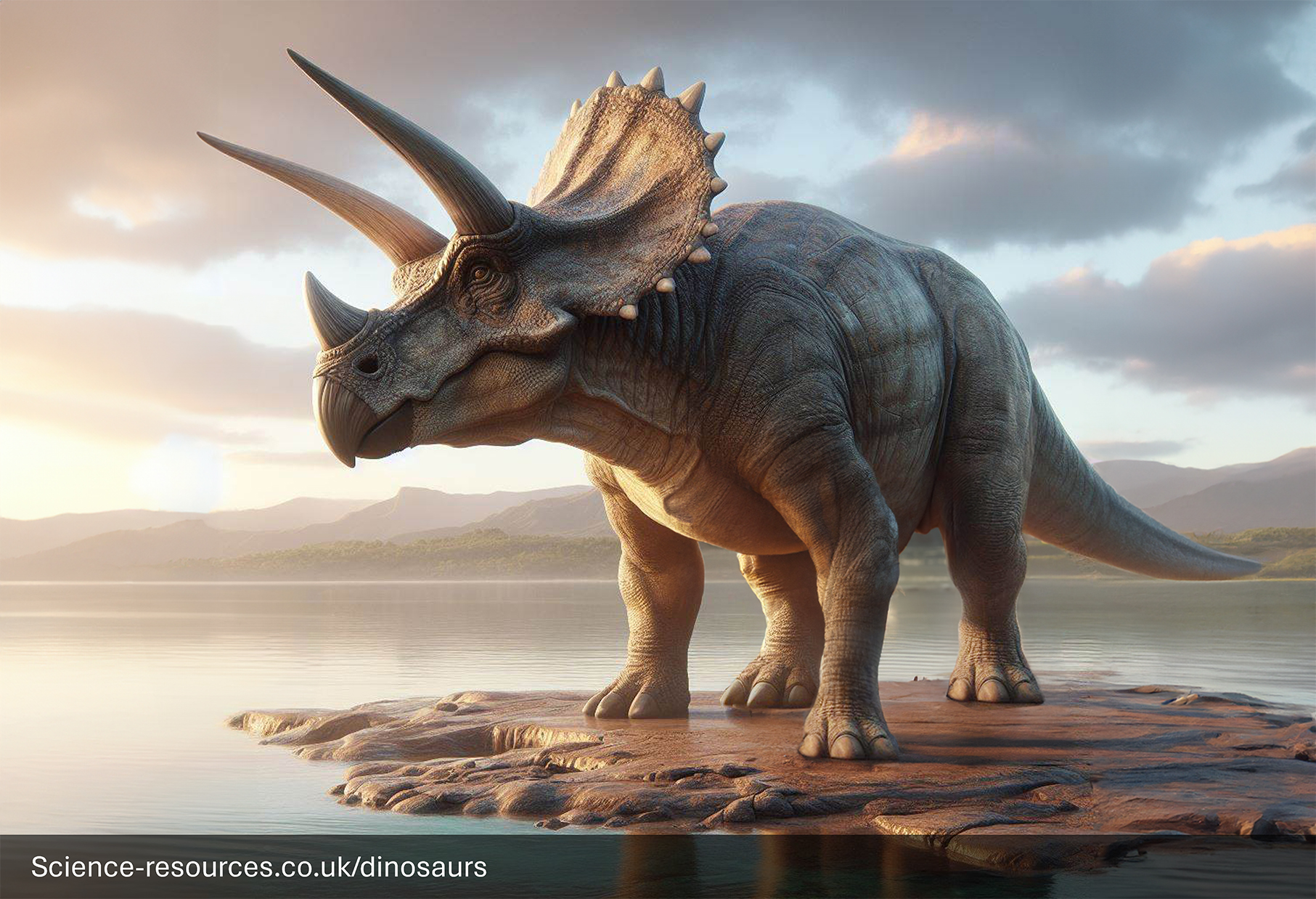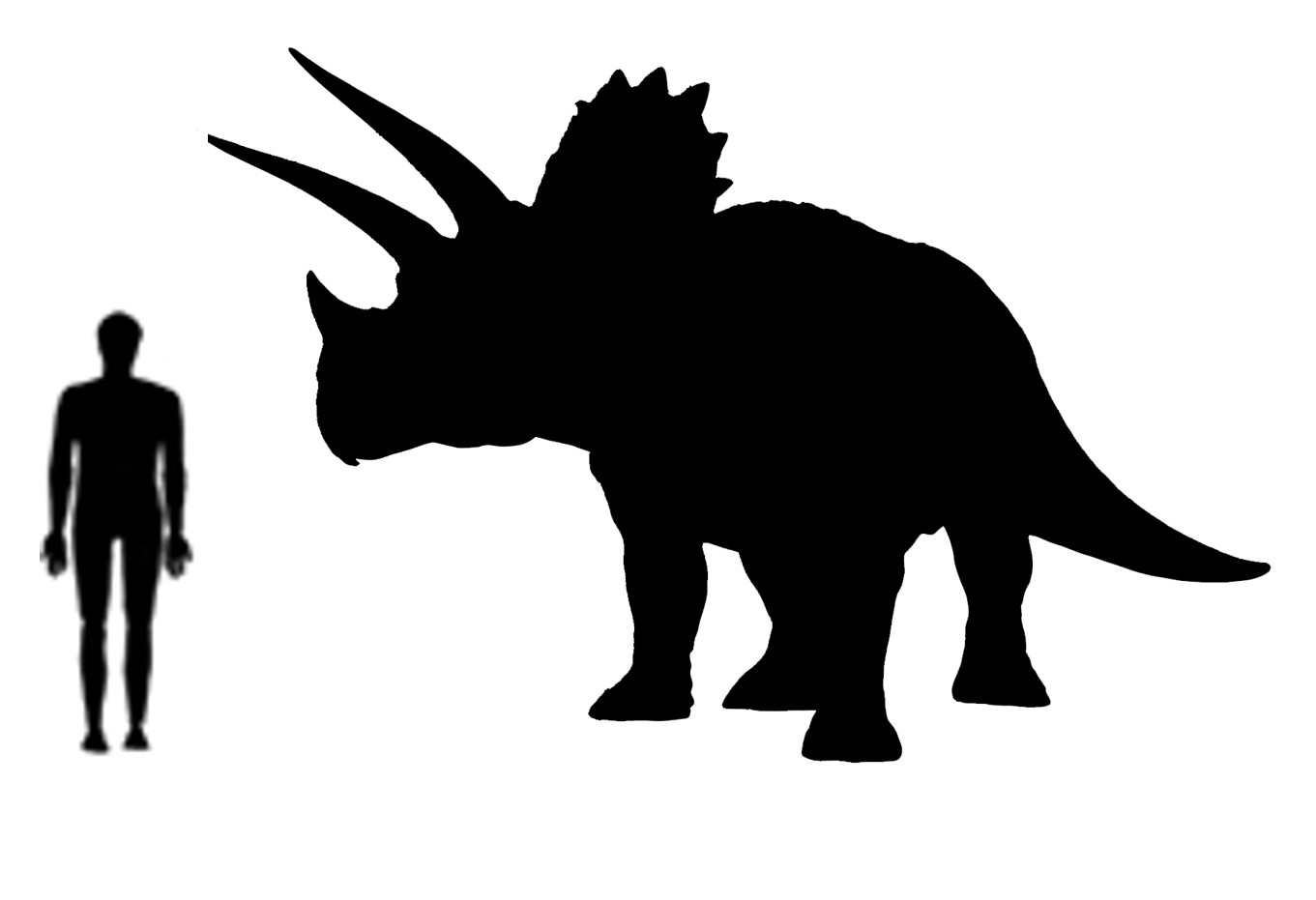Dinosaurs A:Z | T
You may also be intrested in: Free Dinosaur games
Dinosaurs: Triceratops (Three-Horn Face)
You may also be intrested in: Free Dinosaur games
Last updated: 15th Mar 2025 Triceratops, meaning "Three-Horn Face" was a large plant-eating dinosaur that lived during the late Cretaceous period, about 69 to 66 million years ago. It is one of the most famous dinosaurs, easily recognised by its three horns and large bony frill. Length: Triceratops could grow up to 9 meters (30 feet) long. Weight: They weighed around 12 tons, which is about the weight of two African elephants! Triceratops had a distinct look with its three horns: two large ones above its eyes and a smaller one on its nose. Triceratops Generative AI Notification: Some elements of this image have been created or enhanced using AI technology. To find out how we create all our dinosaurs, click here. These horns would have
helped defend Triceratops against predators of that time such as Tyrannosaurus.
A number of skeletons show bite marks that match the teeth of Tyrannosaurus.
Triceratops also had a large frill at the back of its head, which could reach nearly 1 meter (3 feet) across. This frill may have helped protect its neck and attract mates. Triceratops looked a bit like a giant, armored rhinoceros. Triceratops was a herbivore, meaning it only ate plants. It had a beak-like mouth and shearing teeth to help pluck and chew tough plants that other dinosaurs couldn't eat. Fossil remains of Triceratops have been found in what is now western North America. They lived alongside other famous dinosaurs like Tyrannosaurus rex. Triceratops is probably the most famous of a large group
of horned dinosaurs called Ceratopsians. Other Ceratopsians included
Chasmosaurus, Protoceratops, Torosaurus and Styracosaurus. Like all other Ceratopsians, Triceratops had a massive hooked beak armed
with shearing teeth.
• Triceratops might have used its horns and frill to fend off attacks from predators like Tyrannosaurus rex. • Some fossils show healed bite marks, indicating that Triceratops could survive predator attacks. • Puncture marks on fossil frills suggest that male Triceratops used their horns to fight each other, likely to impress females. Triceratops is probably the most famous of a large group of horned dinosaurs called Ceratopsians. Other Ceratopsians included Chasmosaurus, Protoceratops, Torosaurus and Styracosaurus. Like all other Ceratopsians, Triceratops had a massive hooked beak armed with shearing teeth. Fossil evidence suggest that Triceratops and other ceratopsians may have travelled in large single species herds, similar to that of modern day herding mammals such as Wildebeest. Small herd of Triceratops dinosaurs.
What is a Triceratops?
How big was Triceratops?
Appearance

 A number of Triceratops skeletons show bite marks that match the teeth of Tyrannosaurus.
A number of Triceratops skeletons show bite marks that match the teeth of Tyrannosaurus. What did Triceratops eat?
Where did Triceratops live?
Interesting facts
Which family of Dinosaurs did Triceratops belong to?

Pronounced: try-SER-a-tops


Triceratops Facts
Name Means: "Three-Horn Face"
Length: 30 feet (9 m)
Height: 8 feet (2.7 m)
Weight: 7 tons (12,000 kg)
Diet: Herbivore (Low-lying
Plants)
Time: Late Cretaceous - 65 million years ago
Habitat: Forests
Fossils Found: Canada, Western North America
The horns and frill of a Triceratops were most likely used for a combination of defense against predators, combat (fighting with other Triceratops), and visual display for communication, mating rituals, and species recognition. Defense: The horns could be used to scare away and fight off predators like the Tyrannosaurus Rex, while the frill might have provided additional protection around the Triceratops' neck. Social Display: Many scientists believe the horns and frill were primarily used for visual communication, potentially to attract mates by showcasing an individual's size and dominance. Species Recognition: The unique shape of the frill could have helped Triceratops recognise each other. Combat: Evidence from fossil injuries suggests that male Triceratops likely used their horns to fight each other for territory or mating rights. Q1: What are Triceratops? A1: Triceratops were large, herbivorous dinosaurs that lived during the Late Cretaceous period, around 68 to 66 million years ago. They are known for their three distinctive facial horns and large bony frill at the back of their heads. Q2: How big was Triceratops? A2: Triceratops could grow up to 30 feet (9 meters) in length and weigh between 6 to 12 tons. Their skulls alone could be nearly 10 feet (3 meters) long. Q3: Did Triceratops have feathers? A3: No, Triceratops did not have feathers. Unlike some other dinosaurs, Triceratops had a scaly skin and were not closely related to birds. Q4: Were Triceratops intelligent? A4: Triceratops had relatively small brains compared to their body size, suggesting they were not very intelligent. Their brain size was about the size of a human fist. Q5: What did Triceratops eat? A5: Triceratops were herbivores and primarily ate tough vegetation such as cycads, palms, and ferns. They had a beak-like mouth and rows of shearing teeth to help them process plant material. Q6: Did Triceratops live in herds? A6: While Triceratops fossils are often found alone, there is some evidence suggesting they may have lived in small groups or herds, particularly for protection against predators. Q7: How did Triceratops evolve? A7: Triceratops evolved from earlier ceratopsian dinosaurs. They were among the last non-avian dinosaurs to evolve before the mass extinction event 66 million years ago. Q8: What new discoveries have been made about Triceratops? A8: Recent discoveries include new species related to Triceratops, such as Lokiceratops rangiformis, which had unique horn structures. These findings help scientists understand the diversity and evolution of ceratopsian dinosaurs. Q9: What were the horns and frill of Triceratops used for? A9: The horns and frill of Triceratops were likely used for defense against predators, as well as for display purposes in mating rituals and establishing social dominance
What were the horns and frill of a Triceratops for?
Triceratops FAQ
You may also be intrested in:
Tags: How big was Triceratops, Triceratops size, where does Triceratops live, how tall are Triceratops, what does Megalosaurus mean, Triceratops, Triceratops facts